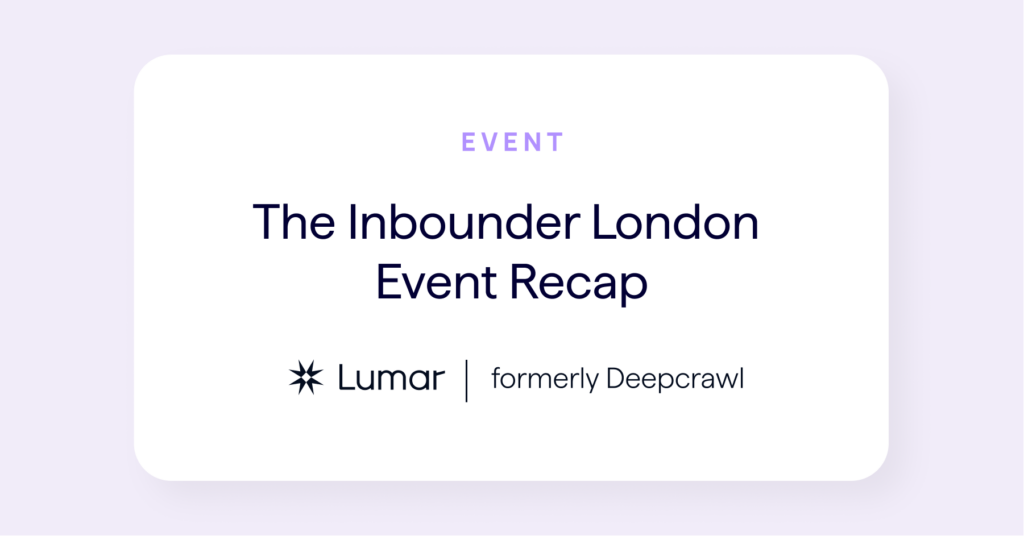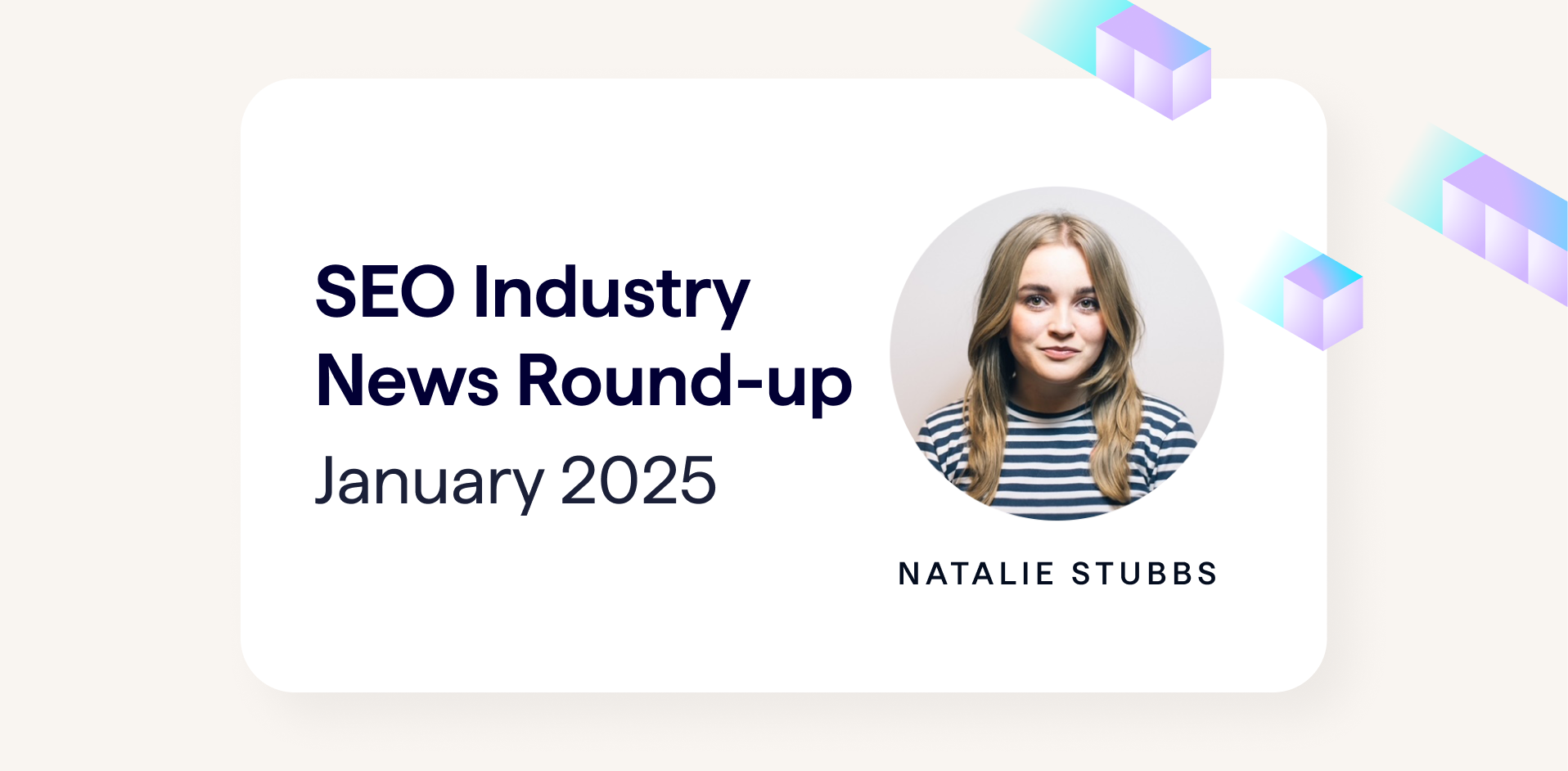
Tuesday 2nd May saw The Inbounder roll into town for the London leg of its 2017 World Tour. After the success of the previous Inbounder events in Madrid and Valencia, it was no surprise the London event pulled in a crowd of attendees eager to get the most from a day packed full of inbound marketing tips, insights and strategies from ten top speakers.
If you weren’t lucky enough to attend The Inbounder or want to revisit the presentations, here’s a roundup of each at the DeepCrawl sponsored event. A big thank you to Gianluca Fiorelli for organizing the event!
Tom Anthony – 3 Techniques for the Modern Age of SEO
Key takeaways:
1. Start split testing your SEO – Come to data driven decisions rather than relying on SEO best practice. Tom’s testing has shown:
- Alt attributes have no impact on SEO.
- Text content on category pages had positive impact on one site and and a negative impact on another site (not every site is the same).
- Title tags matching highest search volume term resulted in a decrease in traffic.
- CSS fallbacks on Javascript enabled pages resulted in a 6% traffic increase.
- Adding structured markup on category pages on a per product basis resulted in an 11% increase in traffic and a five figure revenue uplift.
2. Machine learning – It isn’t necessary to have a detailed knowledge of machine learning techniques in order to understand it.
- Machine learning is important for SEOs because of how much algorithms’ rely on it. With so much data coming from so many devices, there’s a competitive advantage to be gained!
- Machine learning can be used for:
- Categorization – is it right or not? (e.g. Identifying spammy sites).
- Prediction – What can be expected? (e.g. How much traffic can be expected?).
- Clustering – Bunching together common elements (e.g. Categories of keywords).
3. Move towards a ‘hub and spoke*’ based model – API based approach
- Currently there is a slow uptake to new channels which allows early-adopting newcomers to take hold of the market, like Tinder did for mobile dating 😉
- In the future, there will be a need for investment in centralized analytics to incorporate different inputs, like voice search.
Test everything on your own site, what’s works for one site might not work on your own site @TomAnthonySEO #theinbounder
— indagomedia (@indagomedia) May 2, 2017
Kelvin Newman – Why Podcasting is the Missing Piece in Your Inbound Strategy & How to Excel in Audio Content
Key takeaways
1. Podcasts are becoming increasingly popular – typically consumed by an educated and highly engaged audience
- 24% Americans listen to podcasts on a monthly basis (67 million people).
- 14% year on year growth, despite visibility issues.
- More than half listen to 3+ podcasts per week, over a fifth listen to 6+ per week.
- 85% listen to majority of podcast.
2. Ingredients for a good podcast = interesting people + stuff to talk about
3. Consistency and frequency of publishing are very important factors
- Successful podcasts aren’t necessarily the best quality but those that persist.
- Your first 10 podcasts will terrible, so don’t be disheartened.
- Make sure to launch with several episodes as podcasters like to binge.
4. Podcast set ups don’t have to be expensive – You can get started with a laptop, quicktime player and a small room.
5. Hosting and distribution
- Submit your podcast to iTunes
- Hosting options include: Libsyn, Blubrry, Spreaker, Podbean, acast, SoundCloud
6. Optimize for SEO – Write show notes and invest in transcription of your podcast episode using services like Speechpad, Import.io and TNT.
@kelvinnewman doesn’t let the audience down again. Great talk at #theinbounder on using podcasts. With some very useful tips.
— Andrew Halliday (@AHalliday) May 2, 2017
Olga Andrienko – User Psychology and Social Media: Triggers That Drive Conversions
Key takeaways
1. Research competition, identify where you’re better and focus on those strengths.
- Research competition at a person level – on LinkedIn. e.g. If you’re Head of SEO at Missguided, check out the Heads of SEO at Boohoo and ASOS.
2. Four components of social media presence: creativity, freedom, budget and responsibility.
3. Pick social media platforms suitable for your business – Use Buzzsumo for research.
4. Use visuals – people love data (catchy graphs), emojis, screenshots with important data highlighted also works well.
5. Tag people – Employees important in broadcasting message – Get them to share, tag (relevant) people you know to expand your reach.
6. Listen to relevant discussions and hashtags and respond – Create the ‘wow effect’. E.g.@hiltonsuggests provides suggestions for exploring places which is useful to people and may influence their purchasing decision later in the funnel.
7. Make it easier for people to share your content – Help users spread the word (e.g. encourage sharing for event or webinar sign ups).
8. Colours matter and fonts impact outcome
- Colours mean different things to different cultures. Adapt based on who you are targeting.
- Fonts correlate with emotions. Typography is a visual summary of copy. Make sure it matches!
9. Make room for user-generated content – E.g. SEMRush weekly twitter chat, then summary of best tips, then infographic, shareable quotes, as content can be repurposed!
10. Optimize social media pages to maximize conversions – For users ready to buy products or services.
11. Diversify, test and repurpose…do what machines can’t – use emotion!
Love this tip from @olgandrievo at #theinbounder Important to remember with all the hype around #machinelearning pic.twitter.com/r4yHEzF49c
— Nicky Kriel (@NickyKriel) May 2, 2017
Hannah Smith – Going Down the Rabbit Hole – Chaos, Curiosity & Creativity
Key takeaways
1. Have lots of creative ideas – but be aware that only in one will be 20 worth pursuing.
2. Our definition of creativity is too narrow – ditch originality and combine different ideas together.
3. Find things you love and build upon them e.g. movie deaths example.
4. Thieve ideas in a ‘good’ way, steal responsibly.
5. Get inspiration from everywhere (e.g. Reddit, or a library!)
6. Shares are a reasonable proxy for emotional strength.
7. Work out where you want coverage, find out what people share – but more importantly WHY they share it.
- What are the most shared posts and why are they at that level of popularity.
8. Understand your target audience – if you don’t, the content will miss the mark. If don’t understand, talk to someone who does.
9. Keep anything worth stealing.
10. Combine stuff you love with topics your target audience care about.
@hannah_bo_banna talks about ‘Good’ vs ‘Bad’ theft! Great #contentmarketing insights and process #theinbounder pic.twitter.com/WWiu6iUPSt
— Jon Ostler (@Jonostler) May 2, 2017
Nichola Stott – 10 Things We’re Checking For a Mobile First Index
Key takeaways
- Mobile first is the biggest single step change in 20 years since Google.
- Nichola thinks the change to a mobile first index will come in June 2018
- Google Webmaster Central blog – Have started experimenting with a mobile first index and will ramp up once they are confident they have a great user experience.
- Mobile first indexing provides an excellent opportunity to beat competitors.
- Huge amount of space to improve site load time.
- 19 second average load time over 3G, but 53% abandon page after only 3 seconds(site speed over 3G).
1. Check mobile agent/client handling
- Make no assumptions and check samples in a device lab.
- Not much to do if site is responsive. Look at behavioural data and look at user behaviour for different devices. Is there room for improvement with UX?
2. HTTP/2 (for mobile or dynamic sites)
- Faster, more progressive web experience, multiplexing, prioritized by type and context, queue is browser to server, keep-alive connection enabled by default.
3. Speed/Front end optimization
- Image optimization – change driver.
- Use image spriting – a collection images put into a single image.
- Operate within Google’s rail framework.
4. Tag handling/GTM
- Tag assistant Chrome extension for tag auditing.
- Tags can slow down sites – switch to GTM.
5. Structured data – Comprehension of entities is important.
- Get into featured snippets.
- Be in the top 3 of the SERPs, answer on the page, structured data.
6. Checking service workers
- Seek to solve biggest problem with mobile – No connectivity.
7. Checking URL hierarchy/ecosystem
- Important if you have subdomains e.g. international sites.
- Don’t rely on alternate or canonical tags to infer hreflang tags.
8. Content experience
- Higher bounce rate on mobile – 10% higher on mobile compared to desktop.
- Aim to offer equivalent experience on different screen. If it’s not mobile first, make it mobile smart!
9. Journey experience
- Make sure the mobile journey works smoothly, may be different from desktop, which shouldn’t be viewed as the default experience (not anymore anyway).
10. HTTPS is a given – switch if you haven’t already, you’ll need to before you can move to HTTP/2.
Bet a lot of people are doing this! “Don’t rely on alternate/canonical tags to infer hreflang tag” @nicolastott #TheInbounder
— Charlie Whitworth (@WhitworthSEO) May 2, 2017
Jono Alderson- Accelerated Mobile – Beyond AMP!
“HTTPS & HTTP/2 are the future of the way the internet works”-Jono Alderson
Key takeaways
1. There are issues with AMP, but it should still be used as there are benefits to switching over.
- AMP Issues: breaks easily, caching – possibility of seeing out-of-date information, not aligned the way other things are on the web, like open graph.
- Most of you should use AMP. You should also understand the implications and tradeoffs.
- No direct SEO benefit but secondary benefits to AMP e.g. being featured in news carousel.
2. HTTPS is a must and needs to be adopted.
- HTTPS isn’t binary – SSL/TLS and different levels of encryption.
3. Cloudflare does free SSL certificates. Problem is further away from source. More expensive is faster process and closer to point of origin (like a series of handshakes).
4. HSTS better version of HTTPS, redirects all typed HTTP to HTTPS – hardcoded in. Could save third of a second in load time.
5. HTTP/2 – Of all the things you can do this is the most important.
- Multiplexing allows for transference of many things at once rather than many round trips with HTTP.
- Important because it can shave off half of the load time.
6. Build mobile first – start with small, then if detecting a bigger screen, it will serve larger.
7. SRCSET is the only solution for managing image sizes resolutions.
- Can encode attributes into source. Incorporated into WordPress. Will shave megabytes off image size.
8. Use sprite sheets for icons. Load one image and CSS will intelligently select relevant parts.
- Difficult to maintain as update site but there are resources that can assist with this.
9. WebP is best parts of JPG and PNG combined – Not yet popular, because previously there was no browser support. Upside=75% smaller with no visual difference!
10. No such thing as speed. What are we measuring?
- Pagespeed Insights gives number based on techniques on site, does not measure speed of site.
- Webpagetest looks at all granular parts and how long to load including analytics which doesn’t impact UX.
- Google Chrome Waterfall – Gives real-time analysis of load timings.
- Look for easy wins – It might only be one small request’s that causing bottleneck.
“The problem with a free SSL certificate is that they can be a long way from the source” – @jonoalderson #TheInbounder pic.twitter.com/6JyPPqfXBN
— Steven Howe (@StevenHowe) May 2, 2017
Kirsty Hulse – Content Marketing: How to Work Less and Win More
“It’s easier to get things signed off by interacting with someone, rather than trying to convince them from the ground up” – Kirsty Hulse
Key takeaways
1. Find the absolute easiest route to the results you want.
2. Links are the main goal of content marketing but people also think links are becoming less valuable. Diminishing returns, as over time the same effort will yield worse results from link building.
3. Invest less in content marketing – The aim should be to get links from lower level content not just hero content.
4. Ideas first, execution second.
5. Content traps.
- Day-based campaigns (e.g. International Lobster Day) can be gimmicky and be a barrier to good ideas.
- Use Reddit for content ideation – fun stuff for the creatively challenged.
- Have ideas before going into brainstorming sessions.
- Don’t let colleagues/clients dilute good ideas and pitch your ideas in threes e.g. edgiest/riskiest idea first, then the idea that you want to win, then your third option.
6. Content tips
- Partner with experts – which can help gain attention.
- Amazon New Releases is a gold mine – look for books about to be released because authors will be looking for publicity.
- Pay journalists a small monthly retainer – for advice and distribution of releases, not just writing.
- Make sure releases link to something unique to increase the chance of getting links and avoid being put in the citation zone.
- Journalists are saturated with emails, try to build relationship and contact them on other channels e.g. skype, slack.
- Jot ideas down wherever you feel most inspired, keep a pad of paper by your bed or a waterproof notebook in your shower (game-changer!)
1. Find the absolute easiest route to the results you want
2. Use Reddit
3. Get waterproof notebookThanks @Kirsty_Hulse! #TheInbounder https://t.co/a7jLfqdTln
— DeepCrawl (@DeepCrawl) May 2, 2017
Russell McAthy – Using Machine Learning To Forecast Future Sales, the SEO Way!
“You can’t buy more people than are searching for you” – Russell McAthy
Key takeaways
1. Marketing will be a cross section between data and analytics, programmatic and creative.
2. SEOs biggest challenge is their inability to showcase success (ROI).
3. Set up Goals in Google Analytics and set up Goal Values.
- Goals need to be comparable by assigning values to goals. You can then use values to work out value of individual pages.
4. Last click is the worst way of attributing value. Need to look at whole journey.
5. Machine learning can help with attribution.
- Can work out revenue, CPA, actual costs and attributed revenue per source.
- Machine learning can cluster converting journeys to work out different values of channels.
- Can look at non-converting journeys and work out probability of any visitor converting based on previous behaviour.
- This can be used to inform your marketing strategy.
- E.g. only going to show display ads to blog until 60% chance of converting at which point will remarket to product page.
- Big variance between this form of attribution and last click.
6. Machine learning can help bigger companies identify behavioural trends in larger datasets or variances to investigate on a user-by-user level in smaller data sets.
7. Tool tip – check out DataStudio for visualizations.
8. Learning tip – Check out this SEERinteractive post on ‘dark traffic’.
Social Media and SEO face the same issues. How to prove ROI. @therustybear #TheInbounder pic.twitter.com/hYs1tK9xPu
— Nicky Kriel (@NickyKriel) May 2, 2017
Hannah Thorpe – Content Marketing for Watching Paint Dry
“There’s no such thing as a boring product (or brand), only boring marketing!”- Hannah Thorpe
Key takeaways
1. Though most products are boring, their marketing can be inspiring and exciting.
2. Know your audience
- Who are they? Where do they spend their time? When searching? What do they want?
- Consider audience’s: time to consume, platform, device, location
- YouGov profiling – provides an excellent source of data
3. Reverse engineer why someone bought something – Work out what their motivations, constraints etc. are.
- e.g. bought extension cable>is the senior member of household>is renting>Is looking for creative ways to decorate.
4. Represent your brand values
- Rank brand based on different values: friendly>corporate, modern>traditional etc.
5. Don’t try too hard
- Don’t hijack twitter trends.
- Avoid alliteration, puns (there was some debate about this!) or rhyming.
A-freakin-men to alliteration #TheInbounder pic.twitter.com/y6Ai4tIdD9
— Steven Howe (@StevenHowe) May 2, 2017
Gianluca Fiorelli- The Alphabet of Google and What We Have To Expect Next In Search
Key takeaways
1. When we think of Google we think of algorithm updates and information from Google staff and reporters but we can get information from wider range of sources to understand where Google is headed.
- Webmaster blog – AMP and mobile focused up until end of 2016, now SEO community is talking about this.
- Word cloud of Webmaster blog – Machine learning!
- Recent patents: entity search, local search, vocal search and informational retrieval.
- What companies is Google buying? VR, natural language processing, machine learning, chatbots, vocal search.
- Google About Us page– Informs about Google’s direction – machine learning features heavily.
2. Mobile is winning over desktop in nearly all industries.
3. Google is bringing in tags within images to allow for filtering in search.
4. Rise of mobile local search – Vocal search coming into search queries.
- Identify the entities in your niche and think about connected entities with your brand.
- Tag everything with schema.org
5. GBoard should be viewed as a new source of traffic – New instant messaging platform which allows for search while messaging.
6. Don’t reduce SEO strategy to answering all Google Suggests.
7. SEO is evolving and increasingly overlapping with other marketing disciplines.
8. CTR optimization is not official ranking signal but research paper show they have been tested.
What Google is talking about via @gfiorelli1 #theinbounder pic.twitter.com/gCPU293Brk
— pandable (@pandableco) May 2, 2017
Thank you to all of the speakers! A special mention goes to Distilled’s Tom Anthony, who taught us the best way to peel a banana during his talk on machine learning.
A not so special shout out goes to The Inbounder’s after-party venue, Sway bar, whose sewage aromas and watered down cocktails reminded us of a night in Magaluf we’d rather forget….oh well, we live and learn.
Anyway, we hope that Search Elite is equally insightful next week and hope to see many of you there.





